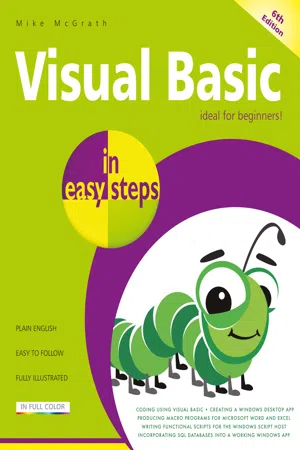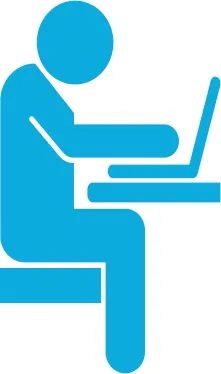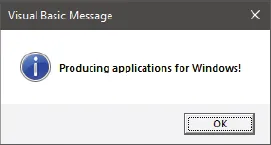
- English
- ePUB (mobile friendly)
- Available on iOS & Android
About this book
Visual Basic in easy steps, 6th edition gives you code examples, screenshots, and step-by-step instructions that illustrate each aspect of Visual Basic so you'll be creating your own interactive applications in no time!.
You need have no previous knowledge of any programming language so it's ideal if you're a newcomer to Windows programming. Each chapter builds your knowledge of Visual Basic. By the end of this book you will have gained a sound understanding of Visual Basic programming and be able to create your own interactive applications.
Visual Basic in easy steps, 5th edition has an easy-to-follow style that will appeal to anyone who wants to begin Windows programming. It will appeal to programmers who want to quickly learn the latest Visual Basic techniques, and to the student who is studying computing at school or college, and to those seeking a career in Information Technology who needs a thorough understanding of Visual Basic programming.
Table of Contents:
- Getting started
- Setting properties
- Using controls
- Learning the language
- Building an application
- Solving problems
- Extending the interface
- Scripting with Visual Basic
- Harnessing data
- Employing databases
Frequently asked questions
- Essential is ideal for learners and professionals who enjoy exploring a wide range of subjects. Access the Essential Library with 800,000+ trusted titles and best-sellers across business, personal growth, and the humanities. Includes unlimited reading time and Standard Read Aloud voice.
- Complete: Perfect for advanced learners and researchers needing full, unrestricted access. Unlock 1.4M+ books across hundreds of subjects, including academic and specialized titles. The Complete Plan also includes advanced features like Premium Read Aloud and Research Assistant.
Please note we cannot support devices running on iOS 13 and Android 7 or earlier. Learn more about using the app.
Information




Table of contents
- Cover
- Title
- Copyright
- Contents
- Preface
- 1 Getting started
- 2 Setting properties
- 3 Using controls
- 4 Learning the language
- 5 Building an application
- 6 Solving problems
- 7 Extending the interface
- 8 Scripting with Visual Basic
- 9 Harnessing data
- 10 Employing databases
- Back Cover